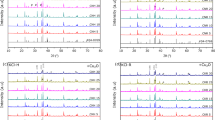Abstract
Zirconia oxynitride rare-earth-doped pigments were prepared by ammonolysis of the zirconium rare-earth oxides, previously synthesized using the citrate complexation/calcination route. Different coloration has been obtained, the intensity of which is a function of the nitrogen amount in the case of the oxynitrides; in the case of the oxides, both color and intensity depend on the doping amount of rare earth. The obtained phases, Zr(1−x)CexO2, Zr(1−x)RxO(2−x/2)□x/2, with R = Eu or Er and Zr(1−x)RxO(2−x/2−3/2y)Ny□x/2■y/2 (R = Ce, Eu, and Er), have been characterized by x-ray powder diffraction, scanning electron microscopy, and reflectance spectra data. These results show that the phases with minor rare-earth concentration adopt a baddeleyite-type structure, with a monoclinic symmetry, space group P21/c. By increasing the rare-earth doping, the obtained phases crystallize with the fluorite structure with tetragonal (P42/nmc) or cubic symmetry (Fm-3m). On the other hand, the study of the magnetic properties of the oxides and oxynitrides indicate a paramagnetic behavior, and in the case of the cerium oxide, the nitridation process produces the reduction from Ce4+ to Ce3+. Diffuse reflectance data and CIE-LAB color coordinates suggest that these ceramics based on nitrogen containing zirconia are expected to be promising candidates as new ecological inorganic pigments.
Similar content being viewed by others
References
Industrial Inorganics Pigments, edited by G. Buxhaum (VCH, Weinheim Germany, 1993).
B. Gonzalo, J. Romero, F. Fernandez, M.J. Torralvo: (Bi,R)2O3 (R: Nd, Sm and Dy) oxides as potencial pigments. J. Alloys Compd. 323–324, 372 (2001).
R. Olazcuaya, G. Le Polles, A. El. Kira, G. Flem Le, P. Maestro: Optical properties of Ce1-xPrx O2 powders and their applications to the coloring ceramics. J. Solid State Chem. 71, 570 (1987).
V. Sanchez, LopèE.F. z, M. Panizza: Characterization of cubic ceria-zirconia powders by x-ray diffraction and vibrational and electronic spectroscopy. Solid State Sci. 5, 1369 (2003).
M. Kakihana, S. Kato, M. Yashima, M. Yoshimura: Preparation of tetragonal ZrO2–12 mol% CeO2 and ZrO2–6 mol% YO1.5 solid solutions at reduced temperature by a simple aqueous solution route using citrid acid as a complexant. J. Alloys Compd. 280, 125 (1998).
Y.B. Cheng, D.P. Thompson: Nitrigen-containing tetragonal zirconia. J. Am. Ceram. Soc. 74, 1135 (1991).
Y.B. Cheng, D.P. Thompson: Role of anion vacancies in nitrogen-stabilized zirconia. J. Am. Ceram. Soc. 76, 683 (1993).
M. Lerch: Nitridation of zirconia. J. Am. Ceram. Soc. 79, 2641 (1996).
S.J. Clarke, C.W. Michie, M.J. Rosseinsky: Structure of Zr2ON2 by neutron powder diffraction: The absence of nitride-oxide ordering. J. Solid State Chem. 146, 399 (1999).
M. Lerch, J. Wrba, J. Lerch: Synthesis and characterization of oxynitrides in the ZrO2-rich part of the systems Ca–Zr–O–N and Mg–Zr–O–N. J. Solid State Chem. 128, 282 (1997).
J. Wrba, M. Lerch: Phase relationships in the ZrO2-rich part of the systems Y–Zr–N–O, Ca–Zr–N–O, and Mg–Zr–N–O up to temperatures of 1150 °C. J. Eur. Ceram. Soc. 18, 1787 (1998).
J. Wendel, M. Lerch, W. Laqua: Novel zirconia-based superionic conductors: The electrical conductivity of Y–Zr–O–N materials. J. Solid State Chem. 142, 163 (1999).
S. Gutzov, M. Lerch: Optical properties of europium containing zirconium oxynitrides. Opt. Mater. 24, 547 (2003).
S. Gutzov, M. Lerch: Preparation and optical properties of Zr–Ce–O–N materials. J. Eur. Ceram. Soc. 21, 595 (2001).
www.lecoinstrumentos.es.
J. Rodríguez-Carvajal: In Abstracts of the Satellite Meeting on Powder Diffraction of XVth Congress of the Int. Union of Crystallography Toulouse, (1990), p. 127.
R. Pastrana, J. Isasi, R. Sáez: Synthesis and characterization of inorganic pigments based on transition metal oxynitrides. J. Mater. Res. (in press).
E. de la Rosa-Cruz, L.A. Diaz-Torres, J. Rojas Rodriguez: Luminiscence and visible upconversion in nanocrystalline ZrO2:Er3+. Appl. Phys. Lett. 83, 4903 (2003).
Author information
Authors and Affiliations
Corresponding author
Rights and permissions
About this article
Cite this article
Pérez-Estébanez, M., Pastrana-Fábregas, R., Isasi-Marín, J. et al. Inorganic pigments based on fluorite-type oxynitrides. Journal of Materials Research 21, 1427–1433 (2006). https://doi.org/10.1557/jmr.2006.0177
Received:
Accepted:
Published:
Issue Date:
DOI: https://doi.org/10.1557/jmr.2006.0177




